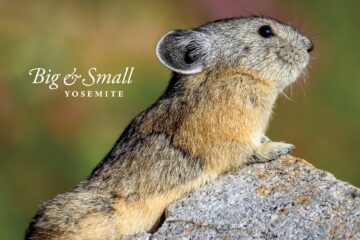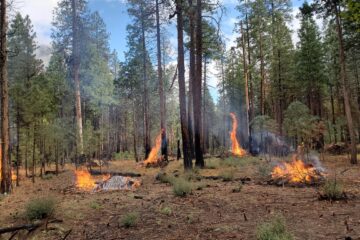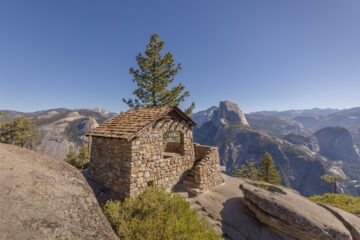While every year is memorable in Yosemite, 2023 was special beyond the centennial celebrations of the Conservancy’s partnership with Yosemite National Park. Reminisce with us as we look at some highlights from the $17 million of support that Conservancy donors provided to Yosemite National Park in 2023.
The record setting snowfalls in the winter of 2023 let the waterfalls gush with vigor all year long. With their dramatic hydrologic displays enthusiastic crowds returned to Yosemite Valley at nearly pre-pandemic levels. Wildflowers, while delayed, bloomed in full floral force, at every altitude in sweet succession in the short and dramatic spring and summer months.
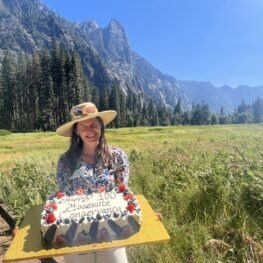
Adonia Ripple, Chief of Yosemite Operations, holding the ceremonial birthday cake on August 4, 2023 – the Conservancy’s 100th birthday.
Over the summer, Yosemite Conservancy celebrated a century of conservation in partnership with Yosemite National Park. The momentous occasion was acknowledged through a series of events including a public celebration on the Yosemite Village Mall on August 3, 2023 with a mounted patrol salute, Happy Birthday sing-along, and a naturalist walk, The Legacy of Yosemite Conservancy’s First Century, by naturalist Dick Ewert.
The Conservancy also launched a Yosemite Stories site. Thousands of you have written in to share your unique stories of Yosemite. From love stories to tales of adventure and coming of age, it’s amazing to see how Yosemite has influenced so many of our lives.
As the year came to a close, the Conservancy celebrated with the park service the completion of the Rehabilitation of Bridalveil Fall. The multi-year project has transformed the sense of arrival to Yosemite Valley with new more accessible trails and viewing platforms of the waterfall as well as new parking and restroom facilities. New interpretation and orientation panels will be installed in 2024.
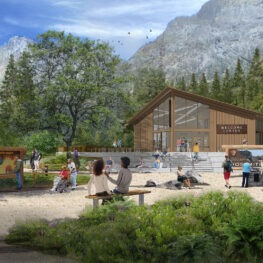
Rendering of the new Welcome Center in Yosemite Valley.
In Yosemite Village, the opening of the Welcome Center ushers in a new chapter of improved visitor services within a newly renovated historic building. Additionally a new exhibit, Yosemite Now, opened in the Yosemite Exploration Center (formerly known as the Yosemite Valley Visitor Center) highlighting the current research themes of the National Park Service.
Read on to learn more about the highlights from the grants that Conservancy donors funded to support Yosemite National Park in 2023.
Trail Rehabilitation and Access: A flood of work for trail crews!
With the record setting snow and elevated water levels in the Yosemite watersheds in the winter of 2023, spring and summer seasons were delayed in some locations and redirected to emerging needs on Yosemite’s legendary trails.
By mid-summer Dave Kari, Trails Supervisor from Yosemite National Park, reported, “After an epic record setting winter, high priority trail logging and maintenance has been accomplished on Valley, Mariposa Grove and Wawona area trails.”
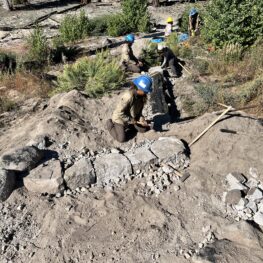
California Conservation Corps members working on Yosemite’s legendary trails in the spring of 2023. Photo courtesy of NPS.
The high priority work included maintenance on 20+ miles of trails including Four Mile Trail, Upper Yosemite Fall Trail, and Mirror Lake Loop in Yosemite Valley; Mariposa Grove Trails, Panorama Trail, and more. Crews removed debris, repaired split rail fencing, and cleared fallen trees. One crew even repaired the Snow Creek switchbacks after a rockslide damaged 2.7 miles of that trail.
Work was completed by a variety of old and new partnerships. The California Conservation Crew (CCC) returned for their 43rd year in Yosemite. CCC crews worked in Yosemite Valley before moving to the Merced and Tuolumne watersheds.
In addition to the CCC’s, this year the Yosemite Ancestral Stewards, an initiative through the park’s Resource Management and Science division, worked on the Tenaya Lake Loop and Murphy Creek Rehabilitation Project,which is expected to be completed in 2024 after a shortened work season due to the snow pack.
“The hope is that the vegetation grows back full force, the social trails are eliminated, and the ecosystem is restored back to a healthy state,” shared Teegan Tucker, a 2023 Yosemite Ancestral Stewards crew member.
Wildlife Management: Snow packed season impacted Yosemite wildlife
Snow from the winter of 2023 greatly impacted the wildlife of Yosemite. Donor-supported grants allowed researchers to make important observations, recommendations for future park management decisions, and set the stage for future work collaboration between work groups.
Yosemite’s Songbird Science Program celebrated 33 years in 2023 of the Monitoring Avian Productivity and Survivorship (MAPS) program in collaboration with the Institute of Bird Populations. The team noted that adult birds were continuing to prospect territories and forage, but that local breeding had significantly decreased this year following the extreme winter.
One of the most exciting captures from 2023 included a recaptured western wood-pewee caught at Hodgdon Meadow on July 3. With the use of its unique band number and the Institute for Bird Populations’ extensive records, the bird banders discovered that this individual was originally banded back in 2016 as a hatching year bird. With this knowledge, the team determined that this bird is now 7 years old!
“The MAPS program here in Yosemite is a wealth of knowledge. There is no other program in North America quite like it with such a long-lasting dataset. The work we are doing is so inspiring because the data we are collecting is answering so many vital questions that will directly lead to conservation applications for the birds in our National Park” – Hallie Daly, MAPS Crew Lead.
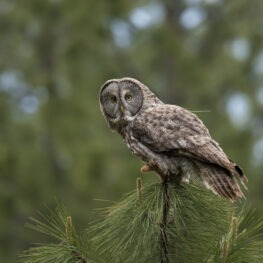
Great grey owl in Yosemite. Photo by Vishal Subramanyan.
Protecting Yosemite’s Endangered Great Grey Owl was able to obtain data this year to learn what great grey owls do during big snow years. Similar to the MAPS data, reproduction was also down for great grey owls.
This multi-year project has been able to utilize data collected from earlier years to inform park planning and management to better protect this incredible species.
In other bird-related news, 2023 tied 2017 and 2018 as one of the highest productive breeding seasons on record of peregrine falcons in Yosemite with 18 breeding pairs. The Peregrine Falcon Protection grant funded an additional level of awareness for peregrine falcons:
“This year, with the use of ArcGIS products, we shared peregrine nest sites and protection zones as a KML file that integrates directly into operational flight maps. Now any pilot operating an aircraft within Yosemite will see peregrine protection zones in real time on their flight map display.,” explained Sarah Stock, Wildlife Biologist with Yosemite National Park. “This achievement showcases our ability to work across divisions and work groups.”
Bat Habitat and White Nose Syndrome also worked collaboratively in 2023. Park scientists worked with Zion National Park to develop a multimethod approach to bat identification that uses collaborations across divisions, agencies, and with the public.
“This year we engaged with the public through being present at Climber’s Coffee and Ask A Climber, and hosting a Cliffside Bat and Bird Sign Workshop for the United in Yosemite Climbing Festival,” shared Shannon Joslin, “Our program educates climbers on the importance and fascinating aspects of bats to encourage the reporting of bat sightings along climbing routes and cliffsides.”
Curious to learn more about the working findings of this team? They were featured in both the Conservancy magazine and an article with National Geographic.
Yosemite National Park’s aquatic’s team worked on two donor-funded projects this year. Yosemite Toad Future Fire Management and Emerging Disease Surveillance in Salamanders surveyed various sites for the respective species at various locations. 2023 was the inaugural salamander survery in Yosemite National Park, providing an important baseline for future studies. Technicians swabbed salamanders and the samples will be analyzed by USGS National WIldlife Health Center for the presense of Bsal.
Yosemite Conservancy donors have supported Bighorn Sheep: Saving a Species for decades. The winter of 2023 had devastating impact on Yosemite’s herds. Estimates show 68% of the collared females have died, most likely related to snow conditions. The most hopeful herd was the Mount Warren Herd where 9 out of 13 ewes survived and 3 of the surviving ewes gave birth to lambs in the spring.
Habitat Restoration: Meadows, acorns, and healing in Yosemite
After many years of planning, Ackerson Meadow Restoration completed Phase 1; earth-excavation was completed through the incredible collaborative support by the donors of American Rivers, Bonneville Environmental Foundation, California Department of Fish and Wildlife, California Wildlife Conservation Board, Google (in association with their Water Stewardship pledge and strategy), National Park Foundation (provided by The Coca-Cola Company, The Coca-Cola Foundation, and Stericycle), National Park Service (provided by Bipartisan Infrastructure Law-Ecosystem Restoration, Concessions Franchise Fee, and NPS Operations), US Forest Service, and the Yosemite Conservancy (listed alphabetically).
Highlights from this year include:
In just 12 weeks approximately 51,000 cubic yards of fill were placed within the erosion channel creating 7.5 acres of restored meadow surface that received seed, erosion blanket, sod, and willow planting between August and November 2023.
Yosemite Conservancy Work Week crews alongside NPS staff helped to collect seeds that will be used during the replanting in 2024.
Yosemite Conservancy donors funded the development of a cutting-edge monitoring method to use scent detection dogs to help locate and save Northwestern Pond Turtles. The funds supported NPS-staff and their dogs to collaborate with and be trained by K9Incentives experts. Through their training, aquatic ecologists and their detection dogs were able to quickly survey all restoration areas right before heavy equipment entered to locate and remove turtles ahead of equipment.
To learn more about the details of the Ackerson Meadow Project, visit the park’s project page.
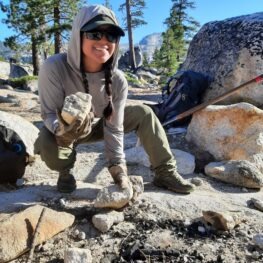
Keep It Wild project at work at Kibbie Lake in Yosemite. Photo courtesy of NPS.
Yosemite National Park is over 95% federally designated Wilderness. Maintaining the quality of designated Wilderness areas for both the ecological and social benefit in the face of increased visitation and climate change, requires incredible efforts. Keep It Wild employed two NPS crews and one Student Conservation Association (SCA) crew to restore 304 sites and maintain 215 sites and treat 54.6 acres of invasive plants in Yosemite’s Wilderness areas.
“The Keep it Wild project minimizes modern human impacts by documenting, removing, and ecologically restoring inappropriately located campsites, fire rings, social trails, and invasive non-native plants. In doing so, we increase Yosemite’s ecological resiliency amid rapid environmental changes and improve future visitor experiences in wilderness.” – Matt Jones, Vegetation and Ecological Restoration, Yosemite National Park.
For the members of the SCA crew, this was their first time living and working in the backcountry. According to one crew member, Nitya Sharma, “I embraced discomfort in many ways. SCA attracts people who have never experienced this before, which is important because we share the outdoors and environmental stewardship with all sorts of people.”
Also working quickly during the truncated High Sierra summer, Tuolumne Meadows Preservation project restored 7.5 acres of meadow habitat from encroaching lodgepole pines by NPS, CCC, Calaveras Healthy Impacts Product Solutions or CHIPS tribal crew, and Yosemite Work Week volunteer groups.
The California Black Oaks: Tribal Stewardship project worked with the Yosemite Ancestral Land Stewards to reduce hazardous fuels in oak groves.
“I personally have seen the difference in these groves after our crew completed the projects. Trees that were fighting for life because of the debris and excess conifers covering them and keeping them from the sunlight were finally out in the open and seemed to be prospering better than ever,” explained Teegan Tucker, 2023 Yosemite Ancestral Stewards crew member. “The Black Oaks create food sources for the natives of the land. The acorns created by these trees produce a large amount of protein and were a large part of the native foods eaten by our people, If not a main food source.”
In addition to clearing hazardous fuels, local tribal groups and Yosemite Ancestral Stewards crews helped to plant oak saplings for future generations. Learn more about the project and its impacts in the short film, Restoring the Tribal Tending of Black Oaks in Yosemite Valley, produced by local Tribal filmmakers, Tisina Parker and Matthew Falcon.
Scientific Research: Fighting against human caused climate change
The NPS continued their work with Ancient Forest Society to Study and Save Sequoias in the Sierra Nevada. In 2023, the group worked in both Yosemite and Sequoia national parks to do isotope sampling, sapflow measurements, and begin the cone/seed collection program. These efforts to study the different environmental stressors of giant sequoias will inform future monitoring effects and management decisions.
One of the breakthroughs of this research to date is identifying the impact of a phloeosinus species or bark beetle on giant sequoias. There is currently efforts to restore recognition and assign the common name: giant sequoia beetle.
“Thanks to funding from Yosemite Conservancy, we have been able to study, monitor and observe dynamic changes in giant sequoia trees and forests at a critical point in history. This funding has allowed us to make important observations about beetles, cones, foliage, fire damage and tree responses to environmental changes in real time,” stated the Ancient Forest Society, who is leading the interagency research efforts.
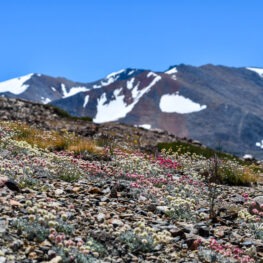
Buckwheat flowers blooming on Mt Gibbs were part of the alpine plant survey. Photo courtesy of NPS.
From protecting the largest tree species by volume on earth, we turn now to the efforts to Protect Alpine Plants in a Changing Climate which focuses on much smaller plant specimens that persist at incredible altitudes.
“We know over the past 30 years we’ve already seen quite a bit of warming in alpine and subalpine areas in Yosemite, based on weather station data, including air temperature data from Dana Meadows,” said Rachel Friesen, a biology masters student from Mariposa who’s in her second year in Dr. Dena Grossenbacher’s lab at California Polytechnic State University, San Luis Obispo.
The new monitoring plots established by Friesen’s team and the GLORIA (Global Observation Research Initiative in Alpine Environments) Great Basin botanists on Mount Dana cover a roughly 1,000-foot elevation band from treeline to ridgeline. Park managers hope research on Mount Dana will help scientists better detect future plant community shifts and conserve unique alpine plant species as climate change continues.
Cultural and Historic Preservation: Creating and preserving human connection to Yosemite
Celebrating Chiura Obata organized another successful Obata Art Weekend in Yosemite Valley with regional artist presenters and the grand premiere showing of “Obata’s Yosemite” film, a donor-supported film. The director, Adam Prieto, and April Kunieda, Yosemite park ranger answered questions from the audience after the premiere.
The Japanese American National Museum and students from the University of California, Merced and supported the event in various capacities.
Ranger Yenyen Chan worked with staff from archeology, history, architecture, and landscape brances on the Chinese American History in Yosemite project in 2023 to consolidate her research to date regarding the Chinese involvement in road development in Yosemite National Park. Her document will help to create internal training material for staff as well as a public facing StoryMap—an interactive web platform that uses maps to tell stories through spatial exhibits—as well as an Interpretive Panel Design with maps, text, and photographs to be placed in a to-be-determined location.
Yosemite’s Horses and Mules assisted greatly in the trail work accomplished this year in the park. In addition to their vital support behind the scenes, Yosemite’s packers and mounted rangers interacted with nearly 10,000 visitors including aiding with search and rescue missions in the park.
With the record setting snowfall, Parsons Memorial Lodge Summer Series, located in the heart of Tuolumne Meadows, was impacted by the late opening of Tioga Road. Despite the challenges, the series reported well attended events with 650 participants enjoying speakers such as Rue Mapp, author of Nature Swagger and founder and CEO of Outdoor Afro, and pulitzer prizing winning poet, Forrest Gander.
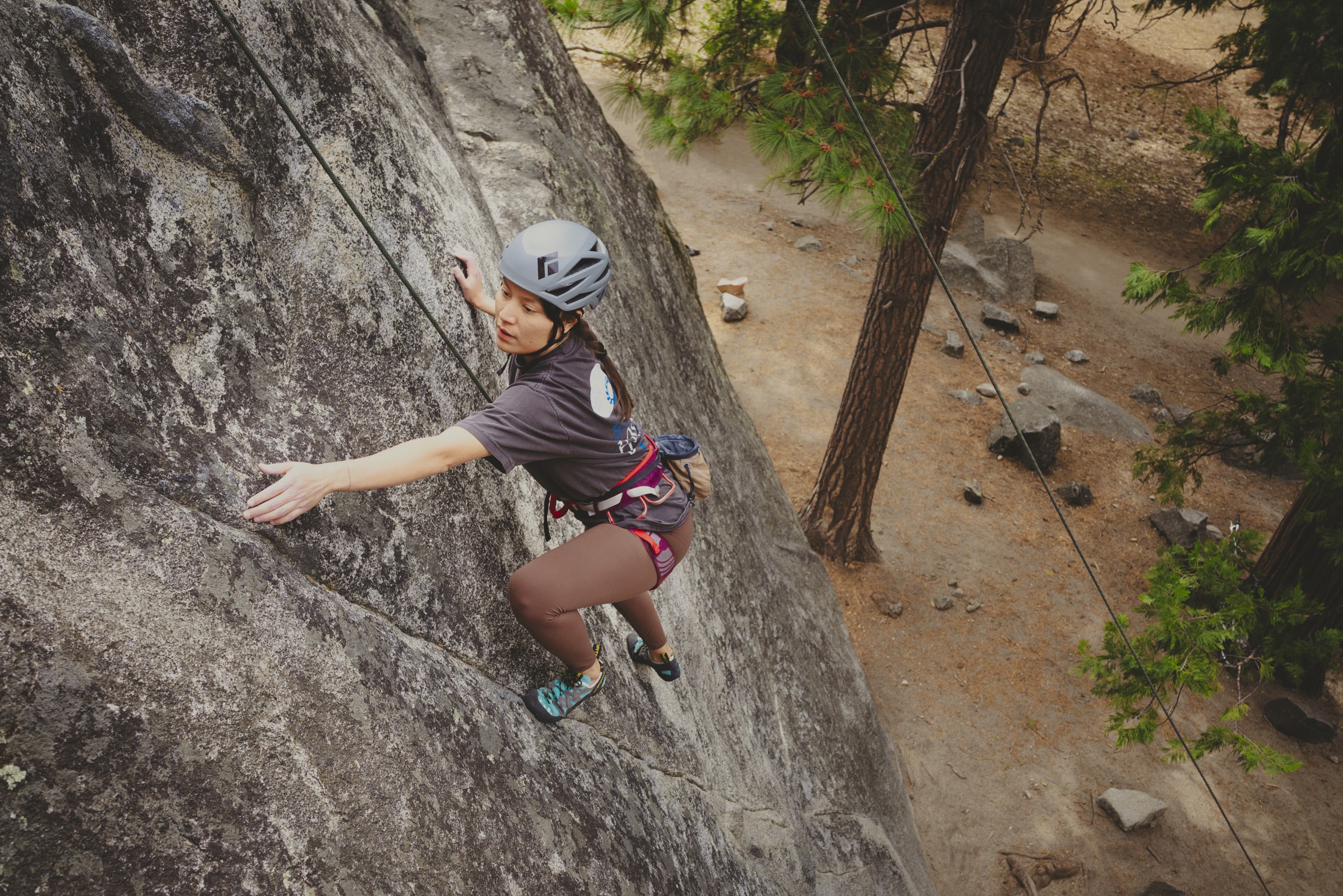
Taking nothing for granite, climbing clinics taught a variety of skills for different levels of climbing experiences. Image by Miya Tsudome.
In 2023, the American Alpine Club and Yosemite Conservancy hosted United in Yosemite. This climbing community event, made possible by the contributions of Brown Girls Climb, Paracliffhangers, Latino Outdoors, Queer Crush Climbing, Farm to Crag, and the Access Fund, presented 6 workshops, 11 clinics and complete 4 stewardship projects in 5 days at no cost to the 100 participants.
“United in Yosemite created a safe, comfortable space in the outdoors that I didn’t know could exist on such a scale. I met lifelong friends and people I will never forget and had conversations that I’m grateful to carry with me for the rest of my life,” reflected an anonymous United in Yosemite participant.
In addition to United in Yosemite, Yosemite Conservancy also supported the Yosemite Climbing Stewardship program and the popular Ask-A-Climber program to support Yosemite’s climbers as well as the climbing-curious public at large. The climber stewards achieved 2,768 climber contacts in the field, collectively patrolling 114 days, 910 pitches, and 218 miles. They also maintained access routes, cleaned up problem areas, and worked with volunteer groups throughout the year.
Finally the Climber Stewards, with additional support from the American Alpine Club were able to transition to year-round self-registration permit process for Overnight Wilderness Climbing (Big Wall climbing), while they received feedback from the public for this new initiative.
Visitor Services, Education, Youth in Yosemite: Making a good impression on future generations
A popular program, Wildlink, is returning to Yosemite in 2024. In 2023 NatureBridge’s Wildlink Manager position was filled, outreach and strategic planning was completed. Regional educators are delighted to see the program back in action.
Working on improving the visitor experience in Yosemite, Yosemite Village Wayfinding installed 37 directional signs and Visitor Use Survey completed an in-park survey with additional mail-back responses in the summer of 2023 and will be presenting analysis and reports in 2024.
As mentioned in several other grant highlights, the Tribal Internships in Resource Careers made it possible to have a Yosemite Ancesttral Stewards crew and a research associate crew lead through the Great Basin Institute.
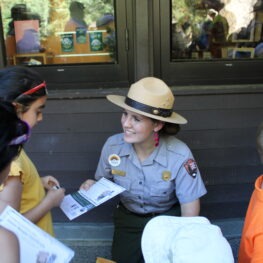
Junior Rangers being sworn in on Junior Ranger Day 2023 in Yosemite. Photo courtesy of NPS.
Junior Rangers in 2023 were presented with many options to connect bilingually with park rangers both virtually through social media videos as well as 12 Spanish bilingual Jr. Ranger programs in the park. 16,209 new junior rangers were sworn in and received their official badges and 7,000 youth attended 340 Jr. Ranger walks and talks in the park.
Parks in Focus® through the Udall Foundation brought three different youth groups up to the park throughout the summer. The trips included a guided photo walk with staff from the Ansel Adams Gallery, a ranger program from ranger Mirella Guitierrez, a former Parks in Focus® trip leader, and others rangers. In total, 31 students were provided more than 175 hours of on-the-ground programming in Yosemite during 2023 Parks in Focus® programs.
In addition to a successful summer immersion course where students spent 19 out of 34 days in the backcountry on three different expeditions with the Adventure Risk Challenge, the staff worked on strategic planning, training, and development.
Sustainability: Steps towards a greener tomorrow
Yosemite Conservancy is committed to supporting the park as we work towards a climate resilient future. This involves several sustainability initiatives from greener transportation with the Yosemite Bike Share to the Zero Landfill Initiative.
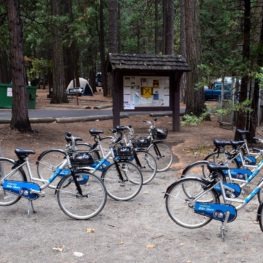
Yosemite Bike Share fleet in the Valley.
In the summer of 2023 3,200 rides were logged by the Yosemite Bike Share bringing our grand total up to 24,428 rides. This program has been generously support by Peet’s Coffee since 2018.
The Conservancy and NPS hosted 11 volunteer fuel canister counts with 93 volunteers helping to divert 29,701 canisters since 2021. The Zero Landfill Initiative also helped produce and debut a short educational film about reusable propane canisters in Yosemite.
Speaking of the Zero Landfill Initiative, the composting program, supported by NatureBridge, Yosemite Hospitality, Mariposa County, and the National Park Service has helped to divert 366.78 tons of waste from the local landfill since the program’s launch in August 2021. In addition to diverting organic waste from the Mariposa County landfill, the Conservancy helped facilitate 6 zero-waste events in 2023 where they collectively diverted 94% of generated waste, or 2,938 pounds.
Thank you for reading!
These incredible achievements (and more) were made possible by the generous support of donors, the work ethic of volunteers, the collaboration of park partners, and efforts of staff. Thank you for supporting Yosemite Conservancy. We look forward to connecting with you in 2024.

